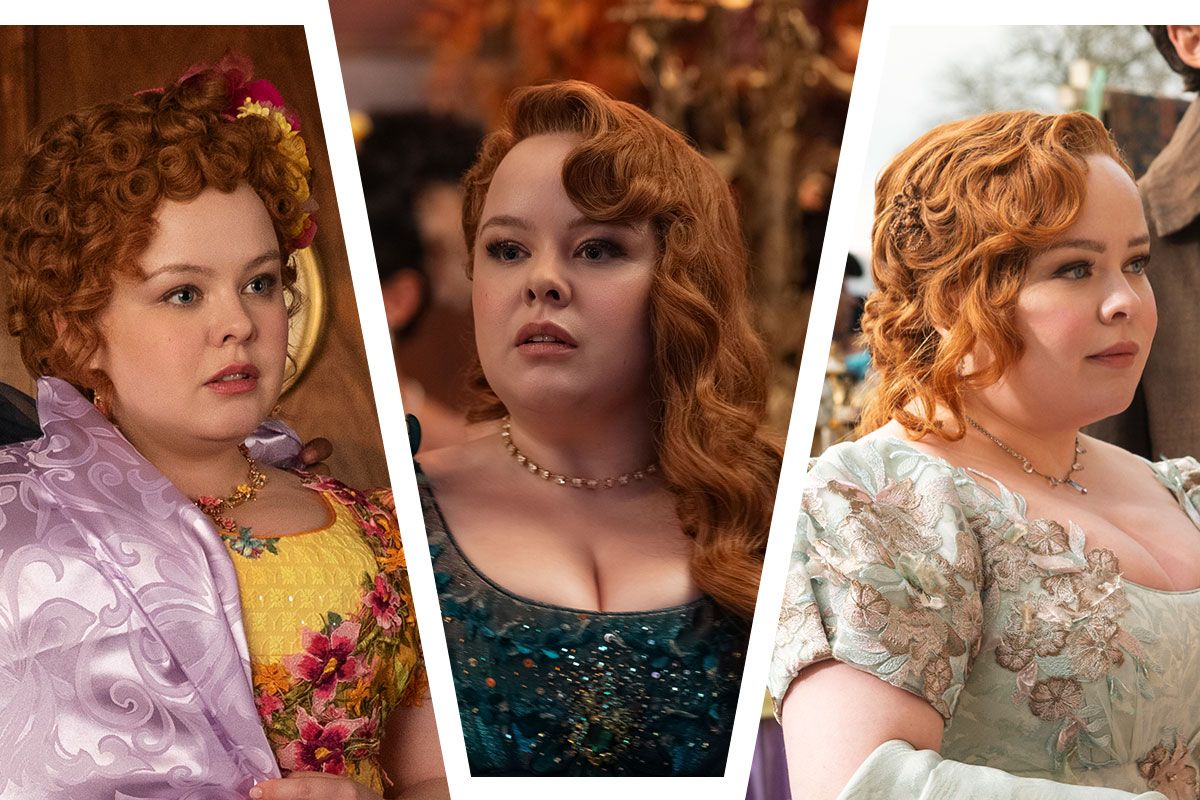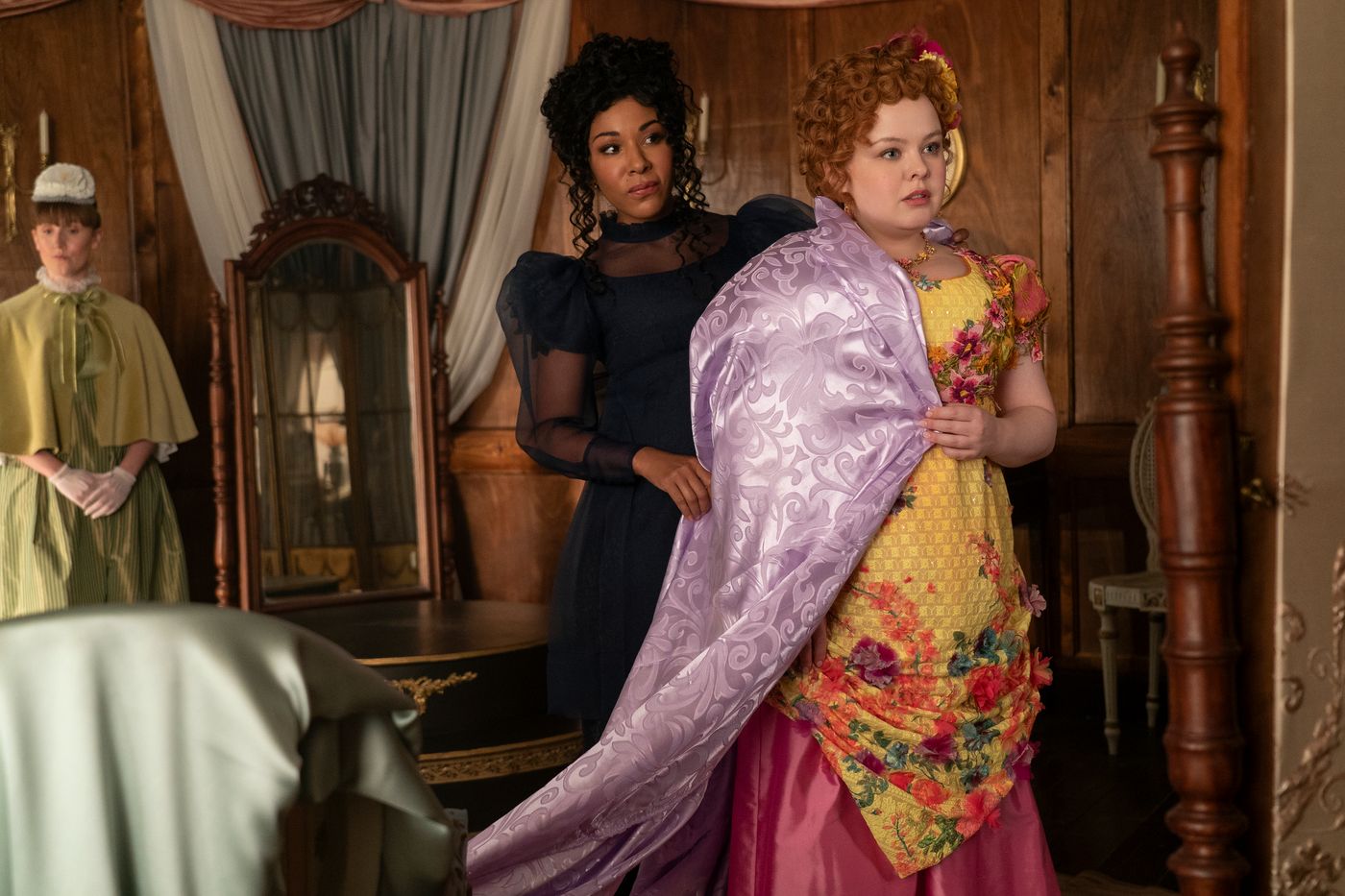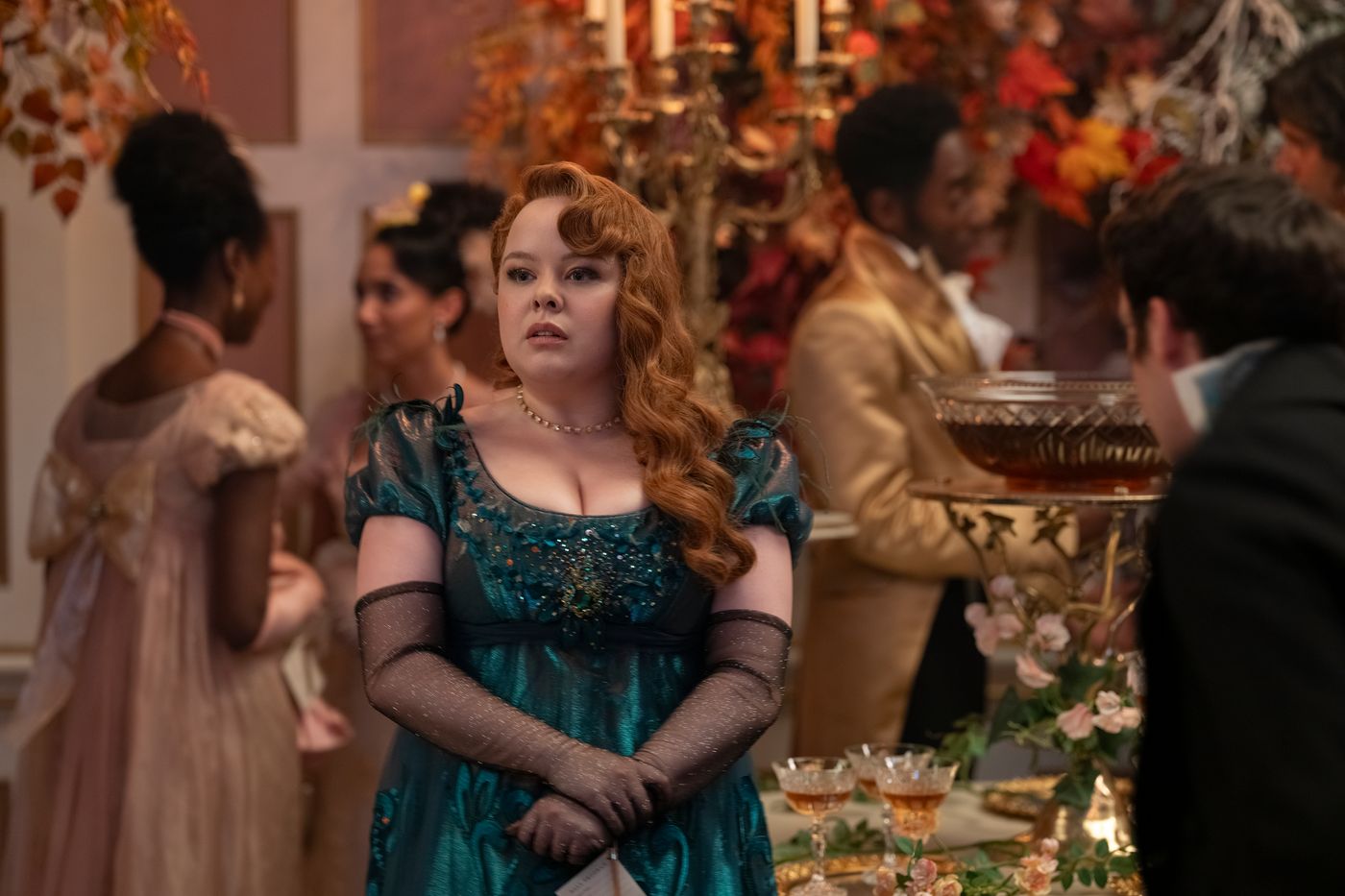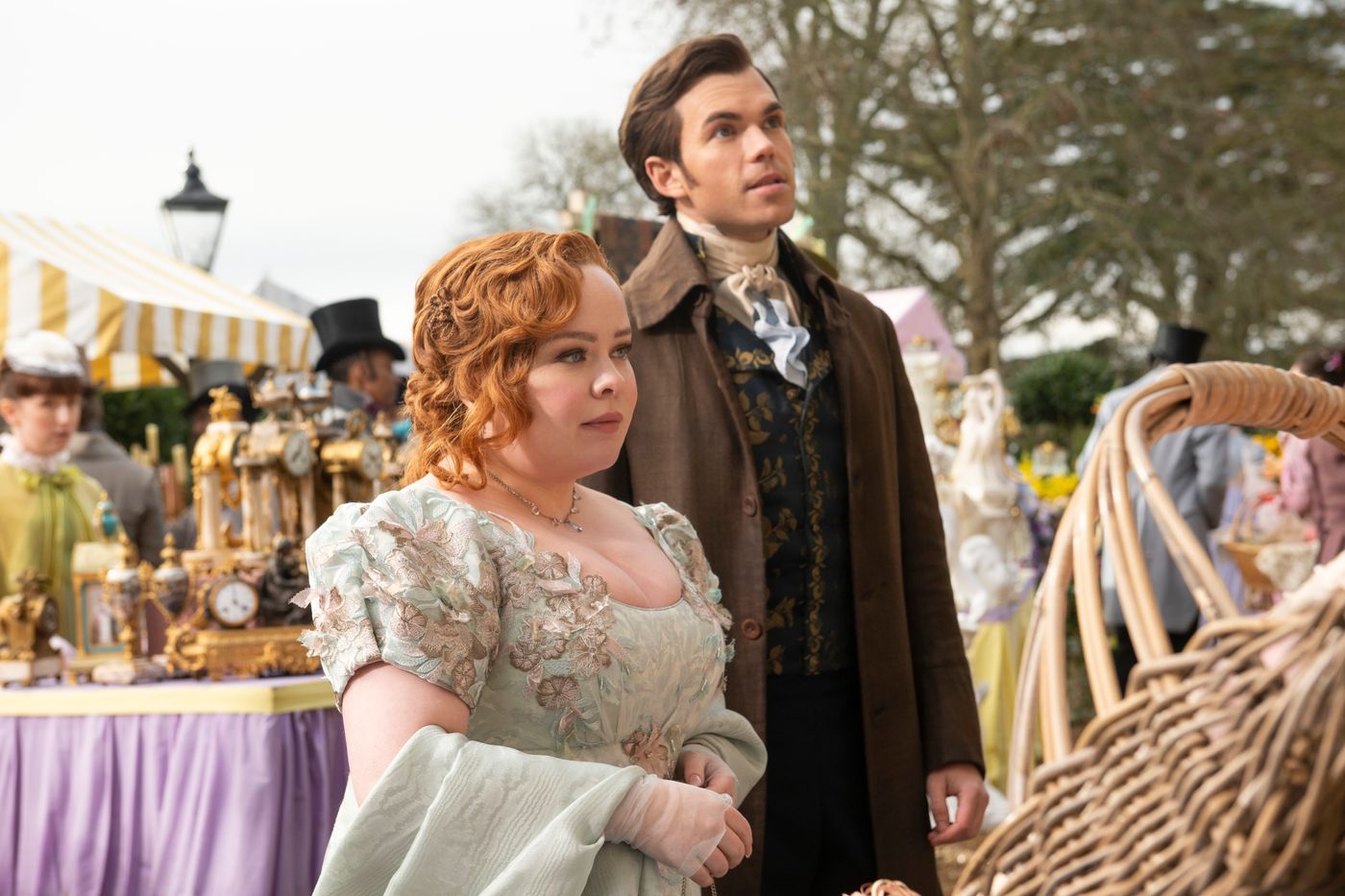‘Her Glow-Up Is Her War Regalia’
How battling for a potential husband changed Penelope Featherington’s colors, corsets, and confidence in Bridgerton season three.

Penelope Featherington is done feeling like a second-class citizen. We meet her restless as ever and estranged from her best friend at the start of Bridgerton’s third season. Even though her proto-Sun gossip pages continue to flourish under the anonymous Lady Whistledown moniker, Penelope is seemingly always home, unhappy, and dreaming of a world where she no longer has to answer to her mother’s authority. She knows what that means, even if it’s a tough pill to swallow: It’s time to take this debutante thing seriously and marry.
So begins the character’s style metamorphosis, which kicks off with a visit to her modiste confidant in the premiere episode. Penelope hopes to find a sensible man who “allows my privacy for obvious reasons” — and she doesn’t want to see a citrus color ever again. Costume designer John Glasner and hair and makeup designer Erika Okvist worked together to create a “look DNA” for this new Penelope, which, after some design tests and research, culminated in changing the shape of actress Nicola Coughlan with better-fitting corsets. It was a simple but wildly effective choice. “They softened the bust line. We see her body,” Glasner says. “She’s no longer a child. She’s a woman, so we wanted her to make her look like a woman.” Draped over Penelope’s corsets are refined shades of green, which becomes her new signature color as she abandons the warm neons of the preferred Featherington palette. Her makeup gets an upgrade too. “We enhanced the sultry cat eyes and pouty lips,” says Okvist. “It was a big change, but it was natural to her.
Penelope’s physical transformation symbolizes a much more dramatic shift happening within her. “She’s now empowered — a person always feels empowered when they feel comfortable in what they’re wearing and it becomes part of them,” says Glasner. “After a while, she realizes she’s quite an elegant lady,” adds Okvist. “She doesn’t want to lie about who she is, she just needs to make this style her own. She becomes a more mature and secure Penelope.”
A shapeless beginning

After her mother declares Penelope will always be around to take care of her, the youngest Featherington realizes the only way she can escape the suffocation of her mother is by finding a husband. (“It is time,” she vents to the modiste.) “She needs to leave that house,” Okvist says. “The means of doing that in those days was to get married and get a house of her own. Therefore her glow up, as it were, is her war regalia to try and get herself a husband.”
Using some of the money she’s saved from her Lady Whistledown column, Penelope suggests exploring a style “like what they’re wearing in Paris,” a subsconscious nod to the international travels Colin Bridgerton brags about earlier in the episode. Glaser took this as an opportunity to elevate Penelope to the heights of fashion: “We veered away from the historical 1813 empire silhouette and pushed her into 1820.” He deployed a two-piece corset to give Penelope an hourglass shape, which changed her posture “like Marilyn Monroe from the 1950s,” he says. “A waist and a fuller skirt works well with her body shape. Instead of fighting her body, we enhanced what’s there.” Okvist also viewed Penelope’s transformation as a “Hollywood starlet” moment: “We went for a siren. Think of Marilyn Monroe or Rita Hayworth; when we look at them we know they look great, but we don’t remember exactly why they look great,” she says. “We just remember that they were style icons. Now, Penelope is wearing the clothes and the clothes aren’t wearing her. We tried to hide those good features in the past.”
Spinning a web of seduction

Penelope’s experimentation offered Glaser a chance to introduce a new color palette with a dramatic unveiling at Lady Danbury’s ball. “The first dress she wears is dark green with black gloves. It’s a color her mother would never allow her to wear,” he explains. (As expected, her mother dismisses the dress as “melancholy.”) Green was chosen because of Bridgerton’s color restrictions established for each of the main families; it’s still a Featherington color, just a different variation of it. The copper in the fabric nods to the family’s penchant for orange, while the black gloves represent the total opposite of anything Penelope’s ever worn. (Burgundy was a no-no — that’s for Danbury only.) “We were thinking in this case the color should still reflect that she’s a Featherington,” Glaser says. “If we put her in blue, the show’s fanatics would’ve said, Oh my God, it’s Bridgerton blue, that means she’s going to … The colors are Easter eggs and sometimes can tell the story, and we don’t want to give anything away with how we use color.”
Instead the costume captures Penelope’s frame of mind. “The base of that dress is netted, so we actually said to ourselves, It’s like she’s spinning a web.” This element of seduction was mirrored in Okvist’s cat-eye shadow for Penelope. “What will snare all these young eligible men? What will make them look at her? There’s one ball, for instance, when Penelope has gemstones in the corner of her eyes,” Okvist explains. “Maybe they will catch the person’s eye who’s dancing with her, and then he’ll look down and see her kissable lips, and then maybe he wants to marry her. She’s spinning that web.”
Finding her comfort zone

Despite the head-turning entrance, Penelope’s new look requires a period of adjustment for the former wallflower, who still struggles when it comes to flirtation as well as the opinions of the ton. (Her sparkly shoes are only seen by viewers when Cressida Cowper, jealous of the attention on Penelope, cruelly steps on her gown, tearing the train.) “Think of it this way: You’ve been stuck in the same clothes your whole life and now you’ve got money,” Glaser explains. “When you look at people on the red carpet who don’t get dressed up all the time, they usually go a little further than a person who gets dressed up frequently because it’s not as natural to them. It’s Penelope’s first attempt at something new, so it was a little off and not quite right. It was too far out of her comfort zone.”
Glaser and Okvist toned down the cooler shades for Penelope’s subsequent looks, including an embroidered light blue floral number worn during the great balloon disaster. “We also brought her colors down so the audience wouldn’t get tired of looking at them,” Glaser says. “It wouldn’t be a joke again, like in the first season with the citrus colors.” This palette gives Penelope the ability to go incognito as Lady Whistledown while complementing a feature much harder to change in the 19th century: her hair color. Against the softer shades in her clothing, Penelope’s auburn hair isn’t quite as noticeable. “Whatever color you put next to another color will reflect back into it,” Okvist notes. “When she’s in a dress that’s blue and green, the opposite colors of red, it calms down the very bright red in the wig. Her skin now looks like velvet butter. Her cheekbones are going up to god. There’s nothing reflecting on a hideously bright-yellow dress anymore.”
Ultimately, Penelope’s new look is meant to enhance her natural features, never distract. “Instead of adding things to her costume, we took things away,” says Glaser. “These looks are much more sophisticated and let her true personality come through.” The clothes, truly, made the woman — Penelope just needed some time to figure out who that woman was.
Related
